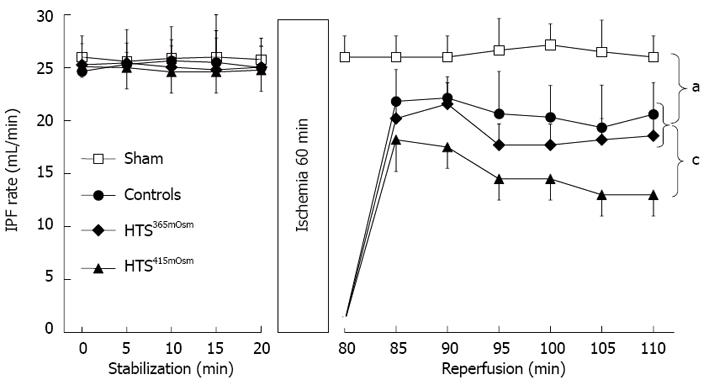Copyright
©2013 Baishideng Publishing Group Co.
World J Gastroenterol. Jan 14, 2013; 19(2): 209-218
Published online Jan 14, 2013. doi: 10.3748/wjg.v19.i2.209
Published online Jan 14, 2013. doi: 10.3748/wjg.v19.i2.209
Figure 2 Intestinal perfusate flow rate in the ex vivo rat experiments with 60-min ischemia followed by varying conditions of reperfusion.
The groups tested were: sham-operated (no ischemia at all, n = 6); controls (30 min reperfusion with normotonic buffer, n = 5); 2 groups with either HTS365mOsm (n = 5) or HTS415mOsm (n = 5), both subjected to 5-min reperfusion with the respective hypertonic solution followed by 25 min reperfusion with normotonic buffer. The pre-ischemic values of Intestinal perfusate flow (IPF) rate were similar in all groups. No changes were apparent in the shams over the whole period, whereas IPF values were lower in all the ischemia-reperfusion groups, although the groups showed different patterns. HTS415mOsm resulted in the most prominent decrease in the IPF rate, with a further progressive fall to the end of the experiment. In contrast, IPF rate was less affected in the control and HTS365mOsm groups, to a similar degree in both, while an appreciable degree of stabilization took place towards the end of the postischemic period. Postischemic IPF rate recovery did not differ between the controls and the HTS365mOsm group, whereas postischemic IPF rate values were significantly lower in the HTS415mOsm group, compared to both the controls and the HTS365mOsm group. Data are mean ± SD. aP < 0.05 vs sham; cP < 0.05 vs controls.
- Citation: Kornyushin O, Galagudza M, Kotslova A, Nutfullina G, Shved N, Nevorotin A, Sedov V, Vlasov T. Intestinal injury can be reduced by intra-arterial postischemic perfusion with hypertonic saline. World J Gastroenterol 2013; 19(2): 209-218
- URL: https://www.wjgnet.com/1007-9327/full/v19/i2/209.htm
- DOI: https://dx.doi.org/10.3748/wjg.v19.i2.209









